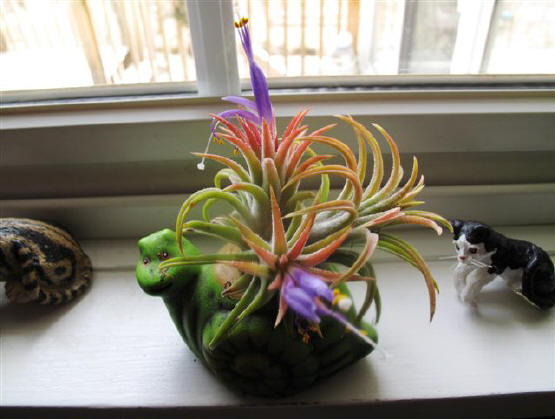 Although not native to our area, Tillandsias are familiar to all of us. If fact, they are almost as ubiquitous as the goldfish in a plastic bag at the local carnivals, for they show up in fancy little containers or attached to
pieces of bark or refrigerator magnates at garden shows and near the cash registers in the garden stores. And there is plenty hanging from the trees in our southern states. The plant in question is the familiar Spanish Moss and its relatives, the air plants.
Although not native to our area, Tillandsias are familiar to all of us. If fact, they are almost as ubiquitous as the goldfish in a plastic bag at the local carnivals, for they show up in fancy little containers or attached to
pieces of bark or refrigerator magnates at garden shows and near the cash registers in the garden stores. And there is plenty hanging from the trees in our southern states. The plant in question is the familiar Spanish Moss and its relatives, the air plants.
These plants are epiphytes. Native to the tropical regions of the Americas, they draw their nourishment from the surrounding air. Their roots serve only to attach them to the tree or rock where they live. Over 500 species of this plant have adapted to a wide variety of geographical zones. And, while
we usually connect them with images of southern plantations and lush jungle and rain forest tree branches, there are some that live on the ground and some have even adapted to desert conditions.
These curious little plants are members of the bromeliad family whose stiff leaves and bright colors are found in many of the indoor gardens in malls because they need so little maintenance. The pineapple is the most visible and well-known bromeliad for most of us.

Spanish moss (Tillandsia usneoides) is the species we are most familiar with since it grows copiously throughout the southern United States. Its loose, filamentous strands hanging from tree branches are synonymous with our image of the southern plantation and of the Florida Everglades. It is hard to
imagine that there are no roots holding these long, sometimes 25 feet, strands to the trees. These strands are really leaves. Hanging from the branch exposes the maximum surface to the moist breezes from which they derive the nutrients necessary for survival. The surface is covered with small gray-green scales, called
trichomes, which trap and absorb moisture and food.
The plant was named by Linnaeus for the Swedish botanist Elis Tillandz who died in 1693. (Note: Plants whose botanical names end in –ia are named for people.)
My little tillandsia came home with me from the spring garden show in Harrisburg a couple of years ago. It is more typical of the kind of plant we think of when we say air plant. It has no stem, the leaves arising from a small rosette that forms the base of the plant. Two or three wiry tendrils
serve as roots, and in the wild they would anchor the plant to a branch. They do not serve any other purpose.
Gray-green triangular leaves keep rising out of the rosette. They are scaly and are covered with minute hairs. They reach widely in all directions, arching gently and ending in very sharp points. In the wild they are reaching for as much exposure to sun and moisture as they can get. The V shape of
the leaves channels the nutrient rich dew and rain to carry the food to the center of the rosette. As it moves the scales trap the nutrients and nourish the plant. Insect debris that gets trapped in the inner part of the rosette provides additional nitrogen. The spacing of the leaves around the central axis allows excess
moisture to drain away, thus preventing the plant from rot and disease.
These plants have very modest requirements when it comes to maintenance and are therefore great companions for those who do not have a lot of time to dedicate to feeding and watering. They tolerate most indoor house temperatures. Make sure they are in an area with circulating air. Keep the plant
reasonably moist. The easiest way to water it is to submerge the entire plant in water or put it under the tap. Do this once or twice a week unless your house is dryer. If the plant becomes dehydrated (the leaves will start to curl) soak in water overnight. Allow to dry out before re-watering. Once a month feed the
tillandsia by adding ¼ tsp of plant food to a gallon of water.
In the warm summer months you can take the plant outside. Hang it in a tree or on the patio to give an unusual touch. The plants like bright light. Be careful not to burn the plant however. Direct summer sun and dry conditions will expose the leaves to sunburn. And the plant will need to be kept
moist.
As you can see, my little plant has grown from a single small rosette to a cluster of six rosettes. It now needs a bigger home than the small turtle container it came home in. It sits in an eastern facing window above the sink. Several times a week we just stick it under the tap and give it a
thorough bath. The pups will continue to grow, or they can be removed and allowed to continue on their own.
And, yes, they flower! My tillandsia welcomed me back from Costa Rica last year with a gorgeous display of deep royal purple flowers the perfect setting for the brilliant yellow style in the center of the flower. They continued to bloom over the next several weeks.
So, if you want a companion that does not make a lot of demands on your time get an air plant. It will brighten up your living space with living greenery. Displaying your new plant will be fun for you and a conversation piece for those visiting your home.
Read other articles on house plants
Read other articles by Phillip Peters